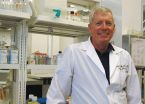(Press-News.org) UPTON, NY - Increasing the oil content of plant biomass could help fulfill the nation's increasing demand for renewable energy feedstocks. But many of the details of how plant leaves make and break down oils have remained a mystery. Now a series of detailed genetic studies conducted at the U.S. Department of Energy's (DOE) Brookhaven National Laboratory and published in The Plant Cell reveals previously unknown biochemical details about those metabolic pathways-including new ways to increase the accumulation of oil in leaves, an abundant source of biomass for fuel production.
Using these methods, the scientists grew experimental Arabidopsis plants whose leaves accumulated 9 percent oil by dry weight, which represents an approximately 150-fold increase in oil content compared to wild type leaves.
"This is an unusually high level of oil accumulation for plant vegetative tissue," said Brookhaven Lab biochemist Changcheng Xu, who led the research team. "In crop plants, whose growth time is longer, if the rate of oil accumulation is the same we could get much higher oil content-possibly as high as 40 percent by weight," he said.
And when it comes to growing plants for biofuels, packing on the calories is the goal, because energy-dense oils give more "bang per bushel" than less-energy-dense leaf carbohydrates.
Deciphering Biochemical Pathways
The key to increasing oil accumulation in these studies was to unravel the details of the biochemical pathways involved in the conversion of carbon into fatty acids, the storage of fatty acids as oil, and the breakdown of oil in leaves. Prior to this research, scientists did not know that these processes were so intimately related.
"We previously thought that oil storage and oil degradation were alternative fates for newly synthesized fatty acids-the building blocks of oils," said Brookhaven biochemist John Shanklin, a collaborator on the studies.
To reveal the connections, Brookhaven's Jillian Fan and other team members used a series of genetic tricks to systematically disable an alphabet soup of enzymes-molecules that mediate a cell's chemical reactions-to see whether and how each had an effect in regulating the various biochemical conversions. They also used radiolabeled versions of fatty acids to trace their paths and learn how quickly they move through the pathway. They then used the findings to map out how the processes take place inside different subcellular structures, some of which you might recognize from high school science classes: the chloroplast, endoplasmic reticulum, storage droplets, and the peroxisome.
"Our goal was to test and understand all the components of the system to fully understand how fatty acids, which are produced in the chloroplasts, are broken down in the peroxisome," Xu said.
Key Findings
The research revealed that there is no direct pathway for fatty acids to move from the chloroplasts to the peroxisome as had previously been assumed. Instead, many complex reactions occur within the endoplasmic reticulum to first convert the fatty acids through a series of intermediates into plant oils. These oils accumulate in storage droplets within the cytoplasm until another enzyme breaks them down to release the fatty acid building blocks. Yet another enzyme must transport the fatty acids into the peroxisome for the final stages of degradation via oxidation. The amount of oil that accumulates at any one time represents a balance between the pathways of synthesis and degradation.
Some previous attempts to increase oil accumulation in leaves have focused on disrupting the breakdown of oils by blocking the action of the enzyme that transports fatty acids into the peroxisome. The reasoning was that the accumulation of fatty acids would have a negative feedback on oil droplet breakdown. High levels of fatty acids remaining in the cytoplasm would inhibit the further breakdown of oil droplets, resulting in higher oil accumulation.
That idea works to some extent, Xu said, but the current research shows it has negative effects on the overall health of the plants. "Plants don't grow as well and there can be other defects," he said.
Based on their new understanding of the detailed biochemical steps that lead to oil breakdown, Xu and his collaborators explored another approach-namely disabling the enzyme one step back in the metabolic process, the one that breaks down oil droplets to release fatty acids.
"If we knock out this enzyme, known as SDP1, we get a large amount of oil accumulating in the leaves," he said, "and without substantial detrimental effects on plant growth."
"This research points to a new and different way to accumulate oil in leaves from that being tried in other labs," Xu said. "In addition, the strategy differs fundamentally from other strategies that are based on adding genes, whereas our strategy is based on disabling or inactivating genes through simple mutations. This work provides a very promising platform for engineering oil production in a non-genetically modified way."
"This work provides another example of how research into basic biochemical mechanisms can lead to knowledge that has great promise to help solve real world problems," concluded Shanklin.
INFORMATION:
This research was conducted by Xu in collaboration with Jilian Fan, Chengshi Yan, and John Shanklin of Brookhaven's Biosciences Department, and Rebecca Roston, now at the University of Nebraska, Lincoln. The work was funded by the DOE Office of Science and made use of a confocal microscope at Brookhaven Lab's Center for Functional Nanomaterials, a DOE Office of Science user facility.
Brookhaven National Laboratory is supported by the Office of Science of the U.S. Department of Energy. The Office of Science is the single largest supporter of basic research in the physical sciences in the United States, and is working to address some of the most pressing challenges of our time. For more information, please visit science.energy.gov.
One of ten national laboratories overseen and primarily funded by the Office of Science of the U.S. Department of Energy (DOE), Brookhaven National Laboratory conducts research in the physical, biomedical, and environmental sciences, as well as in energy technologies and national security. Brookhaven Lab also builds and operates major scientific facilities available to university, industry and government researchers. Brookhaven is operated and managed for DOE's Office of Science by Brookhaven Science Associates, a limited-liability company founded by the Research Foundation for the State University of New York on behalf of Stony Brook University, the largest academic user of Laboratory facilities, and Battelle, a nonprofit applied science and technology organization.
ST. LOUIS -- A vaccine that protects against an old strain of avian flu primes the immune system to mount a rapid response when a vaccine designed to protect against a related but different and new strain of avian flu is given a year later, according to Saint Louis University research findings reported in JAMA.
In addition, when combined with an adjuvant, which is a chemical that stimulates the immune system to produce more antibodies, a lower dose of the new avian flu vaccine worked better in triggering an immune response than a stronger dose without adjuvant. That means ...
A one-day prevalence survey of 183 hospitals found that approximately 50 percent of hospitalized patients included in the survey were receiving antimicrobial drugs, and that about half of these patients were receiving 2 or more antimicrobial drugs, according to a study in the October 8 JAMA, a theme issue on infectious disease. Most antimicrobial use was for infection treatment.
Despite the evidence supporting early, appropriate antimicrobial therapy, a substantial proportion of antimicrobial use in U.S. acute care hospitals may be inappropriate, based on factors such ...
Two randomized trials in the October 8 issue of JAMA examine new vaccination strategies for the prevention and control of avian influenza, often referred to as "bird flu." This is a theme issue on infectious disease.
In one study, Mark J. Mulligan, M.D., of the Emory University School of Medicine, Atlanta, and colleagues compared the safety and antibody responses (immunogenicity) of different doses of influenza A/Shanghai/2/13 (H7N9) vaccine mixed with or without the MF59 adjuvant (a component that improves immunogenicity and enhances efficacy of inactivated influenza ...
Despite no lapses in the disinfection process recommended by the manufacturer being identified, specialized gastrointestinal endoscopes called duodenoscopes had bacterial contamination associated with an outbreak of a highly resistant strain of E coli at a hospital in Illinois, according to a study in the October 8 JAMA, a theme issue on infectious disease.
The duodenoscope is different than that used for routine upper gastrointestinal endoscopy or colonoscopy. The procedure associated with these specialized scopes is endoscopic retrograde cholangiopancreatography (ERCP), ...
Study participants who reported tobacco use or had higher levels of biomarkers of tobacco exposure had a higher prevalence of the sexually transmitted infection, oral human papillomavirus type 16 (HPV-16), according to a study in the October 8 JAMA, a theme issue on infectious disease.
Oral HPV-16 is believed to be responsible for the increase in incidence of oropharyngeal squamous cell cancers in the United States. An association between self-reported number of cigarettes currently smoked per day and oral HPV prevalence has been observed, according to background information ...
Johns Hopkins scientists have shown a strong association between tobacco use or exposure and infection with oral human papillomavirus type 16 (HPV16), the sexually transmitted virus responsible for mouth and throat cancers worldwide. The numbers of such cancers have increased 225 percent in the United States over the past two decades.
HPV16 is found in 80 percent of cancers located in the back of the throat and is transmitted through oral sex. "The practice of oral sex is common, but this cancer is rare. So there must be cofactors in the process that explain why some ...
ANN ARBOR, Mich. — A decade ago, America's health care community took on heart attacks with gusto, harnessing the power of research and data to make sure that every patient got the best possible care.
It worked: Death rates for heart attack have dropped. The same has happened with heart failure and pneumonia. Now, say a pair of University of Michigan Medical School experts, it's time to do the same for sepsis.
Sepsis may not have the same name recognition as heart attacks -- but it now affects more hospital patients, and leads to more hospital costs, than any ...
An experimental vaccine to protect people against H7N9 avian influenza prompted immune responses in 59 percent of volunteers who received two injections at the lowest dosage tested, but only if the vaccine was mixed with adjuvant—a substance that boosts the body's response to vaccination. Without adjuvant, immune responses produced by the investigational vaccine were minimal regardless of vaccine dosage, according to findings from a clinical trial sponsored by the National Institute of Allergy and Infectious Diseases (NIAID), part of the National Institutes of Health.
The ...
A large, NIH-sponsored clinical trial of an experimental H7N9 avian influenza vaccine found an immune response that was believed to be protective in 59 percent of study participants who received two injections of the inactivated vaccine at the lowest dosage tested when mixed with an adjuvant – a component that boosts the body's immune response and enhances the effectiveness of inactivated influenza vaccines.
Participants who received a vaccine without the adjuvant had a minimal immune response.
The results are published in the Journal of the American Medical ...
VIDEO:
This video shows the sole of a shoe as it appears from different perspectives in rendering software. The shoe was placed upside down on an optical table (seen as flat...
Click here for more information.
Researchers at the National Institute of Standards and Technology (NIST) have demonstrated a laser-based imaging system that creates high-definition 3D maps of surfaces from as far away as 10.5 meters.* The method may be useful in diverse fields, including precision machining ...




